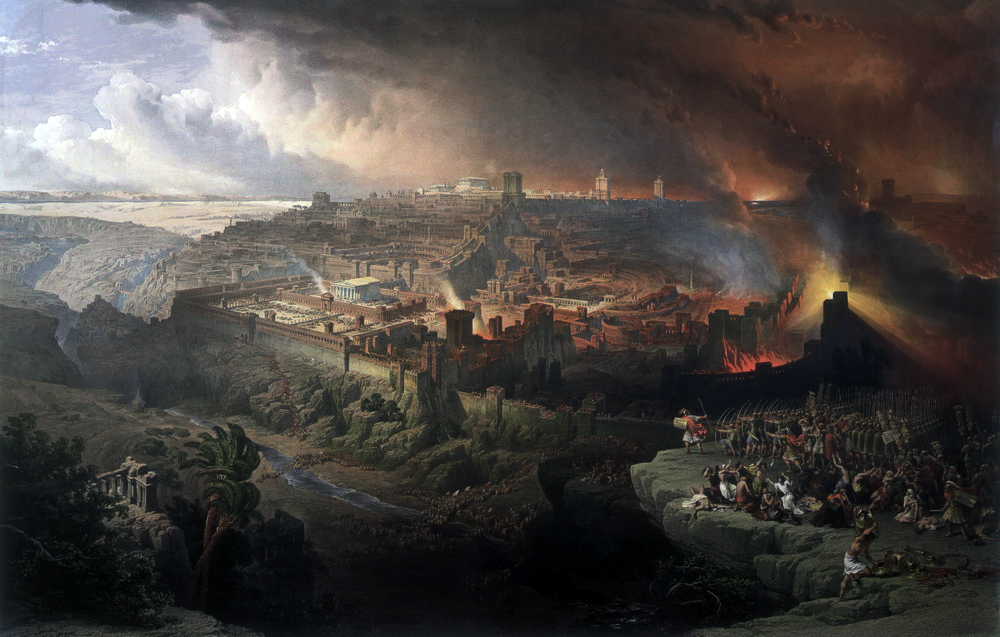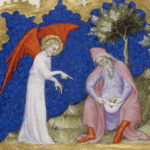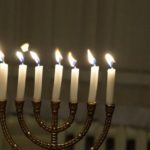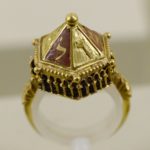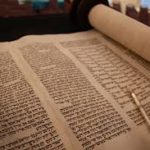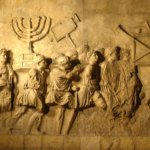They stared after her as she made her way carefully through a crowd of rambunctious children dashing to and fro in the tiny courtyard sandwiched between somewhat shabby apartment buildings. She certainly wasn’t a local resident of this ultra- orthodox neighborhood. Even the youngest among them could see that by the way she was dressed. She was modestly attired, to be sure, but her long brown hair was uncovered and a sharp-eyed nine year old who caught a glimpse of the plain gold band on the appropriate finger assumed an air of self-importance as he announced to those around him, “She’s one of them.”
Esther hardly saw them. Her heart was in her throat; her hands were clammy with anxiety and her eyes darted from one building to another looking for the address that she hoped would bring a resolution to her dilemma.
Climbing the half-flight of stairs to the door marked 7201, she knocked somewhat timidly, raised her eyes to heaven in silent prayer and took a deep breath as she heard footsteps approaching from inside.
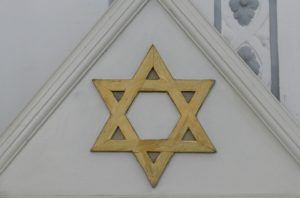 “Yes, may I help you?” asked the bearded young man who opened the door.
“Yes, may I help you?” asked the bearded young man who opened the door.
“I have an appointment.I mean, my friend asked the Rabbi to see me,” she stuttered nervously.
“Come in, come in,” said an unseen voice behind the young man. “Are you Esther?”
Stepping into the apartment, Esther approached the long table at which sat the Rabbi to whom she had been sent. “Yes, kavod Ha Rav,” she replied to the kindly looking man.
“Sit down, please. How can I help you?”
Reaching into a portfolio, Esther withdrew three documents and placed them before the Rabbi, who was flanked on either side by younger men. Pushing his glasses down his nose, Rabbi Slatsky bent his head and peered over the top of his spectacles at each of the yellowed documents, one a time. The room was absolutely silent and Esther wondered if the three men could hear her heart pounding in her chest.
Rabbi’s companions Inspected the Documents
After a long silence during which the Rabbi’s companions also inspected the documents, Rabbi Slatsky finally looked directly at Esther and asked, “Where did you get these?”
“From my aunt, my mother’s sister.”
“Why did she give them to you?” inquired the young man sitting to the Rabbi’s left, his voice taking on something of an intimidating tone.
“My aunt never married and therefore has no children to give them to. She knows that I have been learning Judaism for some time, and she felt that I should have these,” Esther answered, trying to keep her voice steady.
Firmly, but not unkindly, Rabbi Slatsky addressed Esther. “These documents look authentic but they would have to be examined very carefully. Meanwhile, we cannot consider you Jewish at least for the time being. There are too many imposters who try to infiltrate our people with hidden agendas. Documents can be forged for a price. My advice to you is to go back to your goyisha life.” With that, the Rabbi slid the documents back across the table toward Esther.
She made no attempt to retrieve them. Instead, looking steadily at Rabbi Slatsky, Esther said quietly, “Kavod ha Rav, I am here because I am a Jew. I was born a Jew but did not it until two years ago. Unfortunately, while I was growing up, my mother seemed to think it was better if I didn’t know. She only acknowledged it after I found some old photos that made me ask questions.
I did not have the benefit of a Jewish education since I was born and grew up in a completely assimilated family. I am the first in generations of my family to return to orthodox Judaism. I can never go back to what you call my “goyisha life”. Please, help me.”
Her eyes never left the Rabbi’s face. He stirred in his chair, Esther thought, a bit uncomfortably. After a few moments, he returned her gaze and asked, almost brusquely, “What do you mean you can’t go back? Of course you can.”
With a passion that surprised the three men, Esther replied, “With all due respect, no, I can’t go back. There’s nothing and no one to go back to, Rabbi. It is abundantly clear to me that my former religion is false and at any rate, it is no place for a Jew. And secondly, my relatives want nothing of a religious Jew’ in the family.”
“You have friends?” he probed.
Esther smiled weakly. She dropped her eyes and said wistfully, “Friends, Rabbi? Such friends one should have. Every ounce of hidden anti-Semitism surfaced when my friends learned that I was planning to live as a Jew. My “friends”, Rabbi, have disappeared. They think I am damned for turning to Judaism.”
Suddenly Rabbi Slatsky raised one eyebrow, looking directly at Esther’s left hand. “You’re married?” he asked. “You never mentioned it.” It seemed to Esther as if he were slightly annoyed.
“I was married, kavod Ha Rav. My husband was killed” She looked away as her voice broke.
Rabbi Slatsky shuffled the documents still on the table in front of him and muttered, “I’m sorry.” Awkward isn’t a strong enough word to describe the atmosphere that was in the room.
Regaining control, Esther raised her eyes once more and softly said, “Kavod ha Rav, please help me come home to Hashem’s Torah and to my people.”
Rabbi Slatsky leaned back in his large chair and closed his eyes. The young man to his right stood and paced back and forth behind him, hands clasped behind his back. The man to his left sat motionless, staring blankly at the overstuffed bookcase on the opposite wall.
Finally, Rabbi Slatsky spoke, “Do you go to shule?”
Esther Mentioned the name of the synagogue and the name of its Rabbi
Esther gave him the name of the synagogue and the name of its Rabbi. He pulled a small book from a shelf behind him and perused it for a few moments. Putting it down, he simply nodded to the other two men, as if to say, “Yes, it’s there.”
“Can you say the Shema? In Hebrew?” he asked.
 Esther complied, reciting all three paragraphs in flawless Hebrew. The Rabbi sighed and leaned forward over the table, shoulders hunched, face downward. “Such cases are complicated,” he mumbled to no one in particular.
Esther complied, reciting all three paragraphs in flawless Hebrew. The Rabbi sighed and leaned forward over the table, shoulders hunched, face downward. “Such cases are complicated,” he mumbled to no one in particular.
Turning to Esther, he said, “Go back to Rabbi Ben-Ariel. If he sends me a letter attesting to your commitment within the community, then I’ll consider having your documents examined. He’ll know what to write, what I need to know.” He stood, picked up the documents and handed them to Esther. “Take these with you. If we need them, you can always bring them back to me.”
It was obvious the interview was at an end.
“Thank you, Rabbi, for your time,” Esther said respectfully, and noticing a tzedaka box near the doorway, she quietly dropped her previously prepared donation into it as she left.
It was a 20-minute walk back to the Freidman home where Esther lived.
The Friedmans were pillars in the local community and had taken a deep interest in helping and guiding Esther along her journey back to Judaism. They had first met when Esther befriended their youngest daughter several years earlier when the two girls met as teenagers in a computer class at the local library. Tzipi had long since married and was expecting her fourth child. She and Esther had remained friends and it was to Tzipi, that Esther first confided her desire to embrace an orthodox lifestyle. Tzipi had taken Esther to her mother and Hannah Freidman immediately took Esther under her wing.
Esther had been widowed at the tender age of 25, her young husband tragically killed in a work accident just months after they were married. She had returned to her parents’ home shortly after the funeral, unable to continue to live in the newlywed home brimming with memories of their short life together. Esther’s mother had no interest in reconnecting with her heritage and saw no reason why her daughter should either. Esther’s interest in Judaism quickly caused increasing tension between them and Esther soon realized that home’ was no longer home’.
When the Freidmans learned that Esther was looking for a place to rent, they invited her to come and live in the small apartment they had originally added on to their home for Mr. Freidman’s late mother. Hannah Freidman was a superb interior decorator and the tastefully appointed one-bedroom “granny flat” was a cozy and calming haven for Esther. It had been her home now for some 6 years and as Esther often told the Freidmans, it was mi hashemayim, for it made her feel part of a family again. The Freidmans instinctively knew the delicate balance between being there when needed and giving Esther enough privacy for her own sense of independence. Living there not only helped her cope with her widowhood but it also eased the pain of rejection she had suffered from her mother – and her siblings – when she turned to orthodox Judaism.
Hannah was waiting for Esther’s return from the home of the Rav and was about to put the kettle on for tea when she heard the front door open. Rushing from the kitchen, it took no time for Hannah to see the look of anguish on Esther’s face.
“Come, come in the kitchen, dear. Tell me what happened.”
Esther faithfully related the details of her interview, being very careful to speak in the highest terms of respect towards Rabbi Slatsky. However, she could not hide her disappointment that she had left his presence feeling rejected by the one whose approval she needed in order to be officially welcomed into AmYisrael.
Moshe Freidman, as well as Rabbi Ben-Ariel, had assured her that since she was in possession of her maternal grandmother’s Ketubah as well as the same grandmother’s certificate of burial in a Jewish cemetery, along with her mother’s birth certificate indicating she was Jewish, there would be no problem.
But there had been.
Rabbi Slatsky appeared unmoved by the documents and had in her eyes put her off. He had as much said that she wasn’t a Jew, at least as far as he was concerned. And as
far as Esther was concerned, she was very certain that she wasn’t a goy. She felt suspended in thin air, hanging between two worlds and it seemed that neither world wanted her.
Oh, the blessing of an eshet chayil who has the law of kindness on her tongue, as is written in Mishle. In her loving and gentle way, Hannah encouraged Esther to stay the course and to continue learning. “Hashem will make a way,” Hannah declared. “He always does for those who love His Torah.”
And He did, though it was not quick nor was it simple.
Rabbi Ben-Ariel was sympathetic and more than that, devotedly supportive of Esther’s return to her Jewish heritage. He welcomed her into the learning program at the shule and Esther was frequently a Shabbat guest at the Rabbi’s home, each time coming away with new knowledge and new passion for the orthodox lifestyle.
Hannah Freidman accompanied Esther on more than one occasion to additional meetings with Rabbi Slatsky, who after several phone conversations with Rabbi Ben-Ariel had finally agreed to have the documents submitted for certification. Hannah’s presence always gave Esther the moral support she needed when facing the stern, though kind, questioning of Rabbi Slatsky or his assistants.
Esther and Hannah studied together
During this period of prolonged waiting, Esther and Hannah studied together. Esther learned from her mentor the halachot for the Jewish woman and Hannah was thorough in explaining not just the theory but also the practicalities of their observance.
One particular day as they were reviewing together the weekly parsha, which happened to be Parshat Bo describing the Exodus, Hannah looked at Esther and said, “Hashem led our forefathers out of slavery so they could receive the Holy Torah and the Holy Land of Israel. But the journey was not easy, nor was it quick. For forty years, they wandered through the wilderness. No one, Esther, comes to their destiny as a Jew without passing through some kind of wilderness.” It was a statement that Esther took to heart and has since shared with others on the path to Torah observance.
It took four long years for Esther to be accepted by Rabbi Slatsky’s Beit Din as a true Jew. The documents were examined and examined again. Esther was questioned several times about various family members and events of her childhood. It was a long and tedious process.
Through all that time, Hannah was ever available with a positive word and an encouraging smile for the young woman so determined to live as an orthodox Jewess.
Esther in her devotion to study
Esther never slackened in her devotion to study, to learn and to observe mitzvot. Her persistence became an example to many as her story became known.
For Esther, going into the mikveh after receiving the approbation of the Beit Din was more than a dream come true; it was the culmination of years of desire, longing, tears and prayer. Hannah’s tears of joy mingled with Esther’s.
It has now been ten years since the late spring day when Rabbi Slatsky declared to Esther in the presence of the Beit Din, “You are a Jew. Welcome home.” To this day when she recalls that moment, it is with an undiminished sense of joy and thanksgiving.
Today Esther, married again to a wonderful Jewish husband and mother to two lively boys and one very sweet little girl, has become a true eshet chayil in her own right. She credits Hannah Freidman with being her inspiration and her example and as Hannah did for her, Esther now does for others. She is always ready to extend a supportive hand to any woman seeking to walk in Torah and mitzvot.
And shouldn’t we all be just like that?

